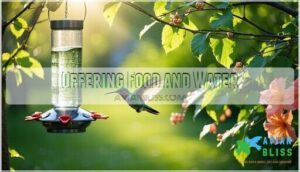This site is supported by our readers. We may earn a commission, at no cost to you, if you purchase through links.
 Ever wondered why hummingbirds stare at you? It’s not personal—they’re just tiny, feathered detectives, using their sharp eyes to figure you out. These birds check if you’re friend, foe, or simply the café owner refilling the nectar bar.
Ever wondered why hummingbirds stare at you? It’s not personal—they’re just tiny, feathered detectives, using their sharp eyes to figure you out. These birds check if you’re friend, foe, or simply the café owner refilling the nectar bar.
Their stares come from curiosity, a quick threat assessment, and an uncanny memory for faces. They even remember folks who keep the sugar water coming! So if you catch a hummingbird sizing you up, don’t feel judged—you might just be part of its daily routine.
Curious what else is on their mind when they hover near your patio?
Table Of Contents
- Key Takeaways
- Why Hummingbirds Stare at Humans
- What Hummingbirds Mean by Staring
- Hummingbird Body Language
- Why Hummingbirds Get Close to Humans
- Decoding Hummingbird Behavior
- Hummingbird Staring and Personality
- When Hummingbirds Stop to Look at People
- How to Respond to a Staring Hummingbird
- When Staring is a Sign of Distress
- Fun Facts About Hummingbirds and Staring
- Frequently Asked Questions (FAQs)
- What does it mean when a hummingbird looks at you?
- What does it mean when a hummingbird gets close to you?
- Do hummingbirds recognize human faces?
- What does it mean when a hummingbird sits by you?
- Can hummingbirds recognize individual human faces?
- Do hummingbirds have different staring behaviors for males and females?
- How long can a hummingbird maintain eye contact?
- Are some hummingbird species more likely to stare than others?
- Can hummingbirds see through windows when staring at humans?
- Can hummingbirds see my pet or other animals?
- Conclusion
Key Takeaways
- Hummingbirds stare at you because they’re curious and want to figure out if you’re a friend, a threat, or just near their food source. – Your red clothes, bright objects, or even certain scents can catch their eye, making you look like a giant flower or possible snack provider. – They remember faces and routines, so if you refill feeders often, they’ll associate you with food and might watch you closely. – A hummingbird’s stare can also be about defending its territory or sizing you up for safety, so stay chill and let the little bird do its thing.
Why Hummingbirds Stare at Humans
When a hummingbird stares at you, it isn’t auditioning for a staring contest—it’s sizing up your shirt, your snacks, or maybe just your presence.
In those rapid-fire glances, the bird assesses whether you’re a source of food, a possible threat, or just another funny-looking giant in its territory.
Attraction to Red Colors
If a hummingbird’s locked its tiny eyes on you, check your outfit—red colors are like neon signs to these birds. Their hummingbird vision is wired for Red Color Perception, connecting you with a Nectar Source Association.
Whether it’s your shirt or hat, Flower Color Preference and Red Clothing Attraction can turn you into the hottest “feeder” in the yard!
Associating Humans With Food
Maybe it’s not just the bright red feeder that’s getting all the stares—it’s you! After all, with human-provided feeders so reliable, these little birds develop learned associations and trust you as their food source.
Your presence can mean a dependable snack, so don’t be surprised if their hummingbird interaction with humans includes a good, curious look before every meal.
Curiosity and Exploration
Caught up in New Object Exploration, you might notice a tiny bird hovering near your hat or watch. That’s pure curiosity in action—part of their Environmental Interaction and Sensory Investigation toolkit.
Young Hummingbirds treat your backyard like a classroom, using their sharp senses and active Learning Behaviors to build a Cognitive Mapping of what’s safe, edible, or just bizarre.
Territorial Defense
Walk into their territory and you’ll catch a front-row view of how fiercely hummingbirds defend what’s theirs.
That intense stare? It’s pure, winged security detail sizing you up.
When it comes to defending their turf, hummingbirds don’t mess around. The males, in particular, turn every showdown into a wild display—darting, chasing, and showing off flashes of attitude.
In the tight quarters of the city, whoever controls the best feeding spot rules the roost, so let them have their stage.
What Hummingbirds Mean by Staring
When a hummingbird locks eyes with you, it’s not trying to start a staring contest—it’s sizing you up, using sharp vision and high-speed thinking to decide if you’re a friend or a threat.
You’ll find that their quick glances mix curiosity with caution, all part of being a tiny bird in a big world.
Recognizing Human Faces
Ever have a tiny bird stare you down like it’s memorizing your morning routine? Hummingbirds’ Facial Feature Detection is sophisticated—they use impressive Pattern Recognition, Visual Acuity, and sharp Memory Retention.
Their Neural Processing lets them pick out familiar human faces, especially those who refill feeders. They may even utilize their impressive spatial memory skills to keep track of dozens of feeding spots. Smart move for a bird who’s always hunting its next snack!
Message From Loved Ones
Ever wondered if a hummingbird’s stare holds a hidden meaning? Many think these tiny birds carry Comfort Signs, acting as gentle messengers from loved ones. While the science favors their sharp facial recognition, folklore offers these ideas:
- A sign of protection
- Afterlife Symbolism
- Spiritual Connection
- Grief Assistance in tough times
- Part of your Healing Process
Forming a Connection
Through Hummingbird interaction with humans, you’re part of a dance built on Mutual Recognition and Building Trust. Your steady presence and treats help the bird link your face with safety, not stress.
Hummingbirds remember familiar human faces, curious about your world. By sharing spaces and acting responsibly, you’re nurturing lasting bonds—a tiny guest, decoding Hummingbird Behavior right beside you.
Memories of Mom
As you notice that lingering stare, you might wonder if a little bird brain is replaying clips from “Mom’s Garden.” Just like us, their memories are full of first flights and nectar moments. Some scents or faces flick a switch—reminding them of safety, shared moments, or even enduring love. That’s how hummingbird symbolism and their knack for recognizing human faces keep every hummingbird interaction with humans unforgettable.
- Familiar garden scents spark curiosity
- Feeding routines echo past lessons
- Shared pauses reveal trust and memory
Hummingbird Body Language
If you’ve ever seen a hummingbird puff up its chest or flash its tail at you, don’t worry—they’re just communicating with you in their own feisty way. You’ll notice everything from bold stares to quick flicks of their wings, as these tiny birds use body language to signal if you’re a friend, a threat, or just standing in the way of their next meal.
Posturing and Dominance
A full-blown show of confidence, Territorial Displays in hummingbirds look like wing displays, tail-fanning, or even aggressive signals aimed squarely at rivals—or you.
They’re experts at Resource Defense, using bold posturing to hold their turf. In the pecking order of hummingbird behavior, dominance isn’t subtle; it’s a lesson in Social Hierarchy, territoriality, and feathered bravado.
Threat Display
Right after you see their posturing, watch for hummingbirds pulling out all the stops if they think you (or another bird) might be a threat. These tiny titans use wild intimidation tactics, each designed to say, “Back off!” through:
- Wing fluttering for confusion
- Dive bombing in aerial attacks
- Sharp beak snapping as aggressive posturing
Courtship Behavior
But those intense stares aren’t always about trouble—they can be full of charm! During mating season, a male may lock eyes as he sweeps the air with wild aerial displays and flares out his finest feathers.
These courtship rituals, packed with flashy maneuvers and sharp vocalizations, help him stand out in the partner selection dance-off.
Nesting and Guarding
Once their dramatic courtship flights wrap up, hummingbirds get down to the serious business of nesting. When it comes to building a home, you’ll notice four main moves:
- Pick secret spots (Nest Site Selection)
- Weave with spider silk (Building Materials)
- Fend off invaders (Predator Defense, territorial defense)
- Watch chicks like detectives (Fledgling Care, Hummingbird nest protection)
These tiny dynamos mean business!
Why Hummingbirds Get Close to Humans
You’re not imagining it—when a hummingbird hovers inches from your face, it’s sizing you up for food, safety, or maybe even your choice in sunglasses.
These tiny birds get close to check out bright colors, investigate new scents, and make sure you’re not a sneaky competitor at their buffet.
Investigating Scents and Sounds
Moving past flashy postures, let’s talk about another layer of hummingbird behavior: they’re drawn to Nectar Scents and curious sounds. Your shampoo, lunch, or even your ringtone can pull them in.
Attuned to Sound Recognition and Predator Cues—like Territorial Songs or Wing Sounds—they hover, listen, and sniff, using avian communication to size up human movements and potential threats.
Exploring New Objects
After checking out the latest scents and sounds, these little feathered investigators zero in on anything new. A streak of red, a shiny earring, or even your water bottle can become the center of their object curiosity.
Thanks to their strong color attraction and mistaken identity instincts, hummingbirds stare and hover to solve the mystery—are you a flower, or just fashionable?
Searching for Food
Curiosity about new objects? That’s just a warm-up. Next, hummingbirds shift gears and look straight at you, sizing up every clue about nectar availability and food sources. Sometimes, it’s your shirt’s color, a shiny watch, or a sugary scent.
Watch for these signs:
- Sudden darting near your pocket
- Persistent hovering by your feeder
- Intense, purposeful staring
Social Interaction
After searching for food, these fast-flying neighbors sometimes stick around just for the company. Chasing, aerial flips, even bold stares, all show social hierarchy and body language at work.
You’ll hear vocal communication—chirping talks aren’t just background noise; they’re hummingbird interaction at its finest. Decoding hummingbird behavior? It’s about more than snacks—sometimes, they just want to see your human face.
Decoding Hummingbird Behavior
When a hummingbird stops and stares at you, it’s not just being nosy—these quick thinkers are gathering clues to figure out if you’re a threat, a friend, or just wearing a suspiciously floral shirt.
You’ll notice they’ve a knack for reading the room, keeping tabs on everything from bright colors to potential rivals, so don’t take their close look too personally.
Assessing Threats
When a hummingbird locks eyes with you, it’s running a high-speed session of Predator Recognition and Risk Assessment. Urban Adaptation means these little birds have learned to scope out new dangers, so your curious stare might look like a Threat Response drill.
Here’s how they check for potential threats:
- Scanning for sudden movements
- Evaluating your size and posture
- Checking for predator-like behavior
- Gauging your proximity
- Deciding if you’re friend, foe, or flower
Marking Territory
Lock eyes with a hummingbird and you’re catching a master at work. That little stare is a warning—it’s protecting its turf!
Using bold Aggressive Displays, sharp Visual Cues, and Resource Defense, it signals, “This nectar’s off-limits.” Tiny as they are, their territorial behavior, from chasing rivals to creative Scent Marking, sets clear boundaries for Territory Size.
Attracting a Mate
From staking out territory, a hummingbird quickly shifts to an impressive audition for love. These birds pull out all the stops with their Courtship Rituals.
Watch for bold displays right in front of you:
- Daring aerial acrobatics
- Dazzling mating courtship dives
- Colorful feather shaking
- Chirpy vocalizations
It’s nature’s reality show.
Guarding a Nest
Birds get seriously protective when they’re guarding a nest. If you see one hovering over you or even swooping down, don’t take it personally—that’s just classic parents keeping their chicks safe.
Here’s what’s going on and how you can handle it:
| Behavior | Meaning | Your Move |
|---|---|---|
| Hovering | Predator vigilance | Stand still |
| Dive-bombing | Warning: territorial | Back off—gently! |
| Chirping | Alerting mate | Lower your voice |
| Perching nearby | Eyeing nest location | Move quietly away |
| Frequent flyovers | Patrol, nest habits | Just exit gracefully |
Hummingbird Staring and Personality
If a hummingbird pauses to give you the full stare-down, you’re not starring in a nature documentary—they’re simply showing off their own personality quirks.
Some are bold and nosy, others a bit shy, but each bird’s unique style comes out the longer you watch.
Differences Based on Species
Take a closer look, and you’ll spot real differences in Species Staring Habits—all hummingbirds aren’t cut from the same cloth.
- Ruby-throated hummingbird: bold, up-close stares
- Rufous hummingbird: territorial, intense eye contact
- Plumage Impact: brighter birds stare more
- Regional Variations: urban hummingbirds, bolder than rural cousins
These quirks explain many Reasons for hummingbird staring!
Individual Hummingbird Traits
While Species Differences matter, each hummingbird you spot brings its own quirks to the feeder. Some are bold, darting straight up with Olympic-level Flight Prowess, while others watch from afar.
You’ll notice unique Learning Ability, sharp Visual Acuity, and even distinct Memory Capacity—all feeding into the many Reasons for hummingbird staring. It’s honestly a living drama!
Impact of Environment
How hummingbirds interact with people really depends on what’s around them. When cities grow and natural habitats shrink, these little birds have to adjust how they find food and keep themselves safe.
Pesticide exposure can put them on edge, too. Creating a safe environment? That’s key—these curious flyers love exploring, but they never forget predator awareness.
When Hummingbirds Stop to Look at People
When a hummingbird stops and looks at you, it’s not just trying to memorize your face for a game of backyard trivia.
It’s actually checking for food, water, or safety, using its sharp senses to figure out if you’re a help, a hindrance, or just the neighborhood’s new garden gnome.
Feeding and Nectar Sources
While watching a hummingbird pause at your feeder, you’re actually witnessing a tiny, feathery taste test. They examine nectar composition, eye up feeder maintenance, and compare your food source to natural flowers or bug snacks. Here’s why those little eyes linger:
- Judging sugar concentration
- Scanning for tasty insect protein
- Memorizing your reliable hummingbird feeding station
Water Sources and Birdbaths
Spotting a hummingbird splashing or staring at your birdbath? They’re not just looking for a drink—clean feathers matter more! Shallow, moving water draws them in. Got feeders nearby? Even better. For an excellent hummingbird spa, consider the tips below:
| Bath Size | Water Depth |
|---|---|
| Small & Cozy | ½ inch max |
| Cleaning Frequency | Water Movement |
| Daily if possible | Gently flowing |
| Winter Baths | |
| Don’t let it freeze! |
Predators and Safety
After hummingbirds sip from your birdbath, they’re not just side-eyeing you for fun. That classic hummingbird staring contest? It’s serious business—these tiny birds are masters of predator assessment. They’re scanning their world for Urban Dangers and testing your intentions as part of evading threats.
You might spot them:
- Perched, scanning for cats or hawks
- Giving you the stink eye
- Plotting escape routes
How to Respond to a Staring Hummingbird
When a hummingbird fixes its gaze on you, it’s not plotting a showdown—it’s just sizing up whether you’re friend, foe, or a walking flower.
Stay calm, move gently, and let the little bird figure you out; you might just earn a front-row seat to feathered curiosity.
Avoiding Eye Contact
Even if you catch a hummingbird’s stare, there’s no need to practice Human Stare Aversion or fret about Social Anxiety. Hummingbirds don’t mind eye contact—they’re just curious. Averting your gaze won’t change much; they aren’t following Cultural Norms or bothered by human faces.
Here’s what your reactions mean:
| Action | Is It Okay? | Why It Matters |
|---|---|---|
| Stare back | Yes | They spot interest, not threat |
| Look away | Yes | They’ll keep exploring |
| Wear sunglasses | Yes | Intrigued by new sights |
| Wink | Yes | Confused, never offended |
Moving Slowly and Calmly
A gentle movement is the golden rule for gaining a hummingbird’s trust. Your calm presence says, “I’m just passing through.” Sudden moves? That’s just asking for a sassy hover.
To make the most of your patient observation, try:
- Slow, steady steps
- Relaxed shoulders
- Open hands
- Quiet breathing
Reduce anxiety, avoid startling, and let curiosity win.
Offering Food and Water
After you’ve paused and let that little bird check you out, earn its trust with a sweet gesture. Mix up a classic Nectar Recipe—just white sugar and water, no fancy dyes.
Keep Hummingbird feeders spotless, reposition them for easy discovery, and place a shallow dish nearby. These feeding stations and water sources turn you into their favorite food source, every season.
Creating a Safe Environment
Once you’ve got feeders up, turn your yard into a safe zone. Use Safe Feeders, stick to natural nectar, and place window decals to cut down on bird crashes.
Keep pets inside, avoid pesticides, and let native flowers and shrubs do the heavy lifting for Nest Protection and Habitat Preservation.
Think of it as building a hummingbird-friendly neighborhood!
When Staring is a Sign of Distress
If a hummingbird’s stare seems a bit too intense, you might be watching a bird that’s on high alert, checking if you’re a threat or just a funny-looking plant.
It’s not personal—sometimes even the bravest little birds signal distress with a sharp look, waiting to see if you’ll back off or start handing out snacks.
Recognizing Stress Signals
Awareness is key to catching Distress Indicators in hummingbird behavior. If a hummingbird stares and you notice these Agitation Signs, it’s showing Fear Responses:
- Rapid wing fluttering (think feathered helicopter)
- Tail twitching like Morse code
- Beak clicking (tiny typewriter noise)
- Excessive panting or open-mouth breathing
Spotting these Hummingbird Body Language signals may prevent hummingbird attacks and ease Flight Behavior or Feather Ruffling.
Providing a Safe Space
Carve out a retreat for hummingbirds by tucking Safe Feeders into shady corners and planting Natural Habitats, like shrubs or small trees. This shields them from predators and limits stress from hummingbird interaction with humans. Even small Conservation Efforts—like using Predator Deterrents—make a difference.
Check out this quick guide below for creating a safe environment:
| Tip | Why It Matters |
|---|---|
| Dense Shrubs | Offers quick escape routes |
| Safe Feeders | Reduces risk of disease |
| Predator Deterrents | Lowers anxiety for feeding birds |
| Minimal Disturbance | Gives birds confidence to return |
| Conservation Efforts | Sustains curiosity and exploration |
Minimizing Human Interaction
You don’t need to hover like your visitors—sometimes, it’s best to let them zip around unbothered. If you catch a hummingbird staring, back off and try these low-key strategies:
- Space feeders wisely for proper Feeder Placement
- Encourage plants for Natural Habitats
- Limit exposure to human faces and bright red clothing
- Reduce Dependency with fewer daily interactions
Let them keep their wings—and nerves—steady.
Seeking Professional Help
If a hummingbird’s stare seems troubled or you spot odd behavior, don’t wait around like a garden gnome—reach out for expert consultation. Birds sometimes need more than a friendly wave.
Here’s your to-do list for tackling eye contact confusion and behavioral issues:
- Call a local Bird Rehabilitation group.
- Consult an avian veterinarian.
- Ask a hummingbird researcher for advice.
Fun Facts About Hummingbirds and Staring
You might be surprised to learn just how sharp a hummingbird’s vision is, especially when one seems to lock eyes with you from midair.
These tiny birds aren’t just curious—they’re masters at spotting colors, remembering faces, and sometimes staring long enough to make you wonder if you’ve got nectar on your shirt.
Unique Visual Abilities
Step into sharp focus and try to see the world from a hummingbird’s tiny perspective—your eyes don’t even come close. These little acrobats boast mind-blowing visual abilities. Check out the visual showdown:
| Feature | Humans | Hummingbirds |
|---|---|---|
| Ultraviolet Perception | None | Excellent |
| Color Range | Millions | Billions |
| Motion Detection | Decent | Lightning-fast |
| Frame Rate | Average | Unbelievable |
Amazing Memory and Learning
Even with a brain the size of a pea, hummingbirds don’t miss a beat. Their memory and learning skills let them ace nature’s version of Jeopardy:
- Recall exact flowers they’ve fed from—Spatial Memory at work
- Master migration using Route Learning and Cognitive Mapping
- Recognize human faces thanks to Imprinting Behavior and keen visual perception
Hummingbird Intelligence
Those quick moves aren’t just luck—hummingbirds show off serious cognitive abilities every day. They’ve got sharp spatial memory, use excellent sensory perception to solve problems, and learn new feeder tricks faster than you’d expect.
Their visual acuity helps spot changes, while memory and curiosity go hand-in-hand, revealing individual traits that make each bird’s learning behavior uniquely clever.
Interesting Hummingbird Behaviors
Ever watched a bird defy gravity? Hummingbirds are loaded with wild tricks thanks to unique flight patterns and superb hummingbird vision. You’ll catch them:
- Flying upside down like little daredevils
- Hovering in mid-air to show off their cognitive abilities and curiosity
- Beating their hearts 1, 200+ times a minute—talk about energy!
Their behaviors, from Feeding Habits to Social Hierarchy, never disappoint.
Frequently Asked Questions (FAQs)
What does it mean when a hummingbird looks at you?
When a hummingbird stares at you, it’s sizing you up—think of it as a feathery bouncer checking guest lists.
It’s curious, cautious, and wants to know if you’re a threat, snack, or just background scenery.
What does it mean when a hummingbird gets close to you?
Imagine this: you’re a bright flower in your own backyard, and suddenly a tiny bird zooms in!
When one gets close, it’s probably sizing up your colors or sniffing out a snack—no handshake required.
Do hummingbirds recognize human faces?
You’re probably wondering if those tiny, speedy birds remember your face. While there’s no evidence hummingbirds recognize individual humans like your dog might, they do remember places, feeders, and consistent routines—so don’t forget their snacks!
What does it mean when a hummingbird sits by you?
When one of these tiny aerial acrobats parks itself next to you, it’s sizing up the scene, scouting food, or maybe just being nosy.
Sit still and enjoy the company—it thinks you’re surprisingly interesting!
Can hummingbirds recognize individual human faces?
You won’t find a hummingbird snapping selfies with you, but experts believe they can get familiar with regular visitors.
If you keep showing up with food, they’ll peg you as the friendly neighbor—no disguise needed.
Do hummingbirds have different staring behaviors for males and females?
You’ll notice male hummingbirds use intense, drawn-out stares to defend territory or show off for rivals, while females stare mainly to assess danger or check out the scene.
It’s their version of people-watching.
How long can a hummingbird maintain eye contact?
Ever wonder if a hummingbird could out-stare you in a contest? You’d probably lose! These tiny daredevils can fix their gaze for several seconds, but usually break off when they’ve sized you up or sensed movement.
Are some hummingbird species more likely to stare than others?
You won’t catch every species of hummingbird giving you the stink eye, but some, especially the more territorial types, really own their space.
Rufous and Anna’s hummingbirds tend to hold eye contact a bit longer.
Can hummingbirds see through windows when staring at humans?
A hummingbird can see movement and shapes through a window, but glass often reflects light, so it can confuse them.
If you’re sitting by the window, you might feel like they’re peeking into your living room!
Can hummingbirds see my pet or other animals?
Yes, they’ve got sharp eyes for small critters, too. Your pet or that sneaky squirrel isn’t invisible—birds spot just about anything that moves.
If it’s nearby, a hummingbird will clock it, feathers and all.
Conclusion
Think of a hummingbird’s stare as a tiny spotlight—nature’s way of putting you center stage. If you’ve ever wondered, “Why do hummingbirds stare at you?” it’s not vanity—it’s their curious way of connecting, checking for food, or defending their patch.
These clever birds remember faces, respond to colors, and judge if you’re a helper or a harmless neighbor. Next time a hummingbird sizes you up, enjoy the special attention and maybe offer a little sugar water!
- https://pmc.ncbi.nlm.nih.gov/articles/PMC5797624/
- https://www.latimes.com/science/sciencenow/la-sci-sn-hummingbird-vision-20170105-story.html
- https://www.sciencefriday.com/segments/hummingbird-vision/
- https://backyardwildlifeconnection.com/2023/10/12/backyard-secret-hummingbirds-recognize-individual-faces/
- https://www.reddit.com/r/hummingbirds/comments/1eh0uhy/why_does_a_hummingbird_keep_flying_super_close_to/


















